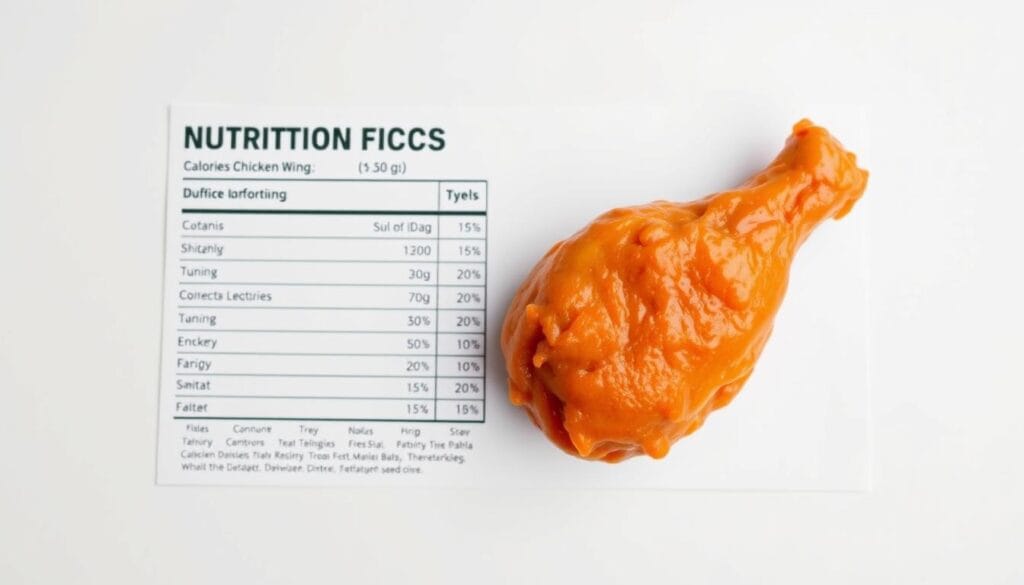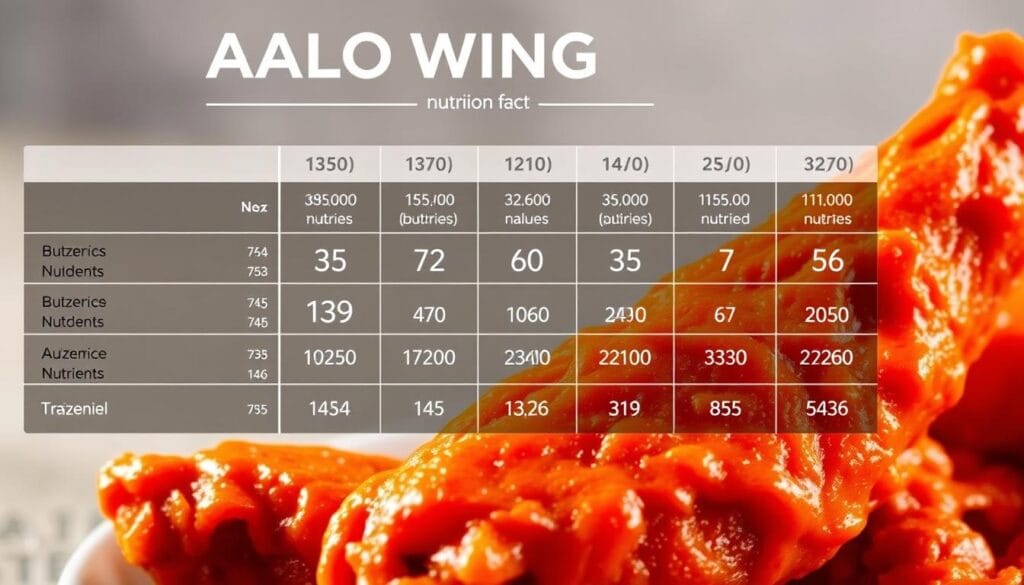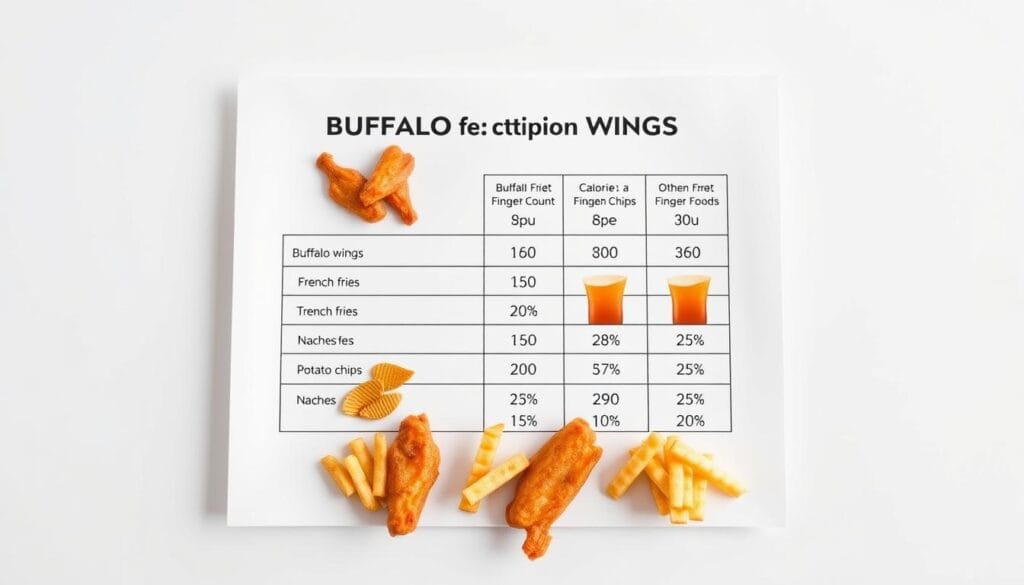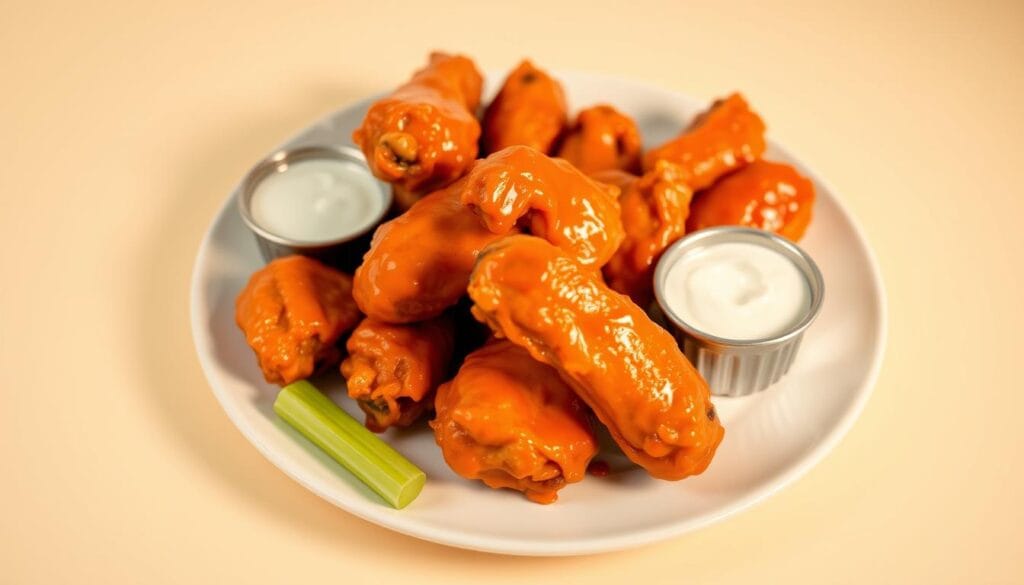Knowing how many calories are in a buffalo chicken wing is key to making smart choices. A single wing has about 86 calories1. But, the total calories change based on the wing’s size and how it’s cooked. For example, 6 wings from places like Jerry’s Subs & Pizza have 510 calories1. A 10-ounce serving can have up to 680 calories2.
These nutrition facts for buffalo chicken wings vary a lot, depending on how they’re made.
Key Takeaways
- A 3-ounce portion of fried wings has 270 calories, but baking cuts this to 1903.
- Each wing offers 6.7g protein and 155mg sodium1, while 10 ounces supply 57g protein2.
- Deep-fried wings with sauce add 140 extra calories per serving3.
- Iron content ranges from 5% to 10% Daily Value per wing12.
- Carbohydrates stay low at 3.25g per wing1, but sodium can hit 1,701mg in large portions2.
Buffalo chicken wing nutrition facts depend on how they’re prepared and their size. This guide helps you understand calorie counts and nutrients. It’s all about finding a balance between taste and health.
Buffalo Wing Nutritional Overview
Understanding the buffalo wing calorie content starts with its nutritional makeup. A typical serving of 6 wings holds about 510 calories. This is split into carbs, fats, and protein. Let’s break it down:
Key Nutrients in Each Wing
- Protein: 38% of calories come from protein, supporting muscle health.
- Fats: 59% of calories stem from fats, with 18g saturated fats per serving.
- Carbs: Only 2% of calories from carbs, mostly from wing coatings.
Breaking Down Caloric Ingredients
The calories in buffalo wing dishes depend on frying oil and batter. Wings deep-fried in vegetable oil add dense fat calories. Sauces like cayenne and butter can boost calorie counts further. Compare this to baked wings, which cut fat by up to 30%.
Knowing these details helps you choose lighter options. Check labels or opt for grilled wings to manage your intake.
The Science Behind Buffalo Chicken Wing Calories
Learning about the buffalo wing calorie count begins with understanding calories. Calories are the energy in protein, fat, and carbs. Chicken wings have protein and fat, but cooking and sauces increase these amounts4.
Deep-frying adds oil to the meat, raising calorie content. Baking, on the other hand, cuts down on oil, lowering the buffalo chicken wing nutritional information a lot4.
- Deep-Fried: Adds 10–15g extra fat per serving due to oil absorption4.
- Baked: Cuts fat by 30–50%, reducing overall calorie count by up to 100 calories per wing4.

Sauces also play a role. Traditional buffalo sauce has vinegar, hot sauce, and butter, adding 50–80 calories per serving from fats and carbs4. Choosing lighter sauces or smaller portions can reduce these calories. The calorie count also depends on wing size—bigger wings have more calories because of more muscle and skin4.
When picking meals, start with cooking methods. Grilled or baked wings with low-calorie dips keep calories down while keeping flavor. Always check labels for buffalo chicken wing nutritional information when eating out to meet your dietary goals4.
How many calories are in a buffalo chicken wing
Looking at a buffalo wing nutrition label, you’ll see different calorie counts. This depends on the wing’s size and how it’s made. For example, a wing from places like Jerry’s Subs & Pizza has about 100–150 calories.
To understand the calorie content of buffalo wings, it’s key to know how these numbers are figured out.
First, we look at the wing’s weight and what it’s made of. Wings are weighed in grams. Each gram of fat, protein, and carbs has 9, 4, and 4 calories, respectively. The way wings are prepared also affects their calorie count.
Fried wings have more calories than baked ones. Here’s a quick comparison:
- Fried wings (3–4 oz): 150–200 calories
- Baked wings: 80–120 calories
- Buffalo sauce: Adds 20–30 calories per serving
| Factor | Calorie Impact |
|---|---|
| Sauce Type | Hot sauce vs. butter-based |
| Cooking Oil | Vegetable oil vs. olive oil |
| Serving Size | 6 wings vs. 10 wings |
Apps like MyFitnessPal can help track these differences. But, always check the buffalo wing nutrition label for the most accurate information. Too much sauce or toppings can turn a 150-calorie wing into 300+ calories.
Buffalo Wing Nutrition Facts and Benefits
Buffalo chicken wings are more than just calories. They also offer protein, B vitamins, and minerals. A 6-piece serving has 30–40g of protein and vitamins B6 and B12.1
How you cook them matters. Baked wings keep more nutrients than fried ones.2

Essential Vitamins and Minerals
Each wing gives you:
- Protein: Helps muscles repair and grow.
- Vitamin B6: Boosts brain function and energy.
- Phosphorus: Good for bones and teeth.
- Selenium: Protects cells as an antioxidant.1
Health Benefits Beyond Calories
Beyond just calories, buffalo wings offer:
- Lean protein: Skinless wings have amino acids for muscles.
- B-vitamins: Turn food into energy and boost immunity.1
- Smart preparation: Baking or air-frying reduces fat while keeping nutrients.2
Enjoy wings with celery or carrot dippers for extra fiber. Choose low-calorie sauces like yogurt dips.2
This way, you can savor the taste without losing out on nutrition.
Different Buffalo Wing Preparation Methods
Choosing how to make your buffalo wings can affect their buffalo wing nutritional value and buffalo chicken wing caloric content. Let’s look at three common ways:
| Method | Calories | Fat Content | Key Notes |
|---|---|---|---|
| Traditional Fried | ~250–350 per wing | 15–25g | Oil absorption increases calories |
| Boneless | ~180–220 per piece | 10–14g | Less batter reduces fat but adds carbs |
| Baked | ~120–170 per wing | 3–8g | Air-frying cuts oil use |
- Traditional frying at places like Jerry’s Subs & Pizza adds 30–40% more calories than baked options
- Baked wings from brands like KFC’s Hot & Spicy line cut fat by 60% while keeping flavor
Go for baked or boneless wings to cut calories without losing flavor. Check restaurant menus for buffalo chicken wing caloric content differences before you order. Small changes in how you prepare them can make a big difference in what you eat.
Understanding the Buffalo Wing Nutrition Label
Reading nutrition labels is key to making smart choices about buffalo chicken wing calories and what’s in them. First, look at the serving size—it affects how many calories you’re getting. Different brands have different sizes, so it’s important to know how to compare.

Interpreting Serving Sizes
- Check the “serving size” listed—often 2-3 wings—then multiply by how many you eat.
- Compare “total calories per serving” to adjust your intake based on your meal plan.
For example, Jerry’s Subs & Pizza lists 3 wings as a serving at 350 calories. Double the wings? Double the buffalo wing nutrition facts.
Comparing Brand Labels
Let’s see how big brands compare:
| Brand | Serving Size | Calories | Key Differences |
|---|---|---|---|
| Wingstop | 3 wings | 460 | Higher fat content from frying oil |
| Buffalo’s Wings & Rings | 4 wings | 520 | Includes dipping sauces adding carbs |
| Jerry’s Subs & Pizza | 3 wings | 350 | Baked wings reduce fat content |
Also, check the sodium levels. Some brands use more salt for taste. Look for brands with less than 600mg per serving.
Always check the ingredient list for additives like MSG or artificial flavors. Choose brands that list whole foods first.
Maximizing Health Benefits from Buffalo Chicken Wings
Enjoying buffalo chicken wings doesn’t mean you have to give up on your diet. Start by cooking wings in healthier ways like baking or grilling instead of frying. This method reduces fat and keeps the meat juicy5. Choose lean chicken breasts to lower the calorie count even more5.
Plan your meals ahead to control portions. Serve wings on small plates to prevent overeating and keep track of what you eat5. Pair them with nutrient-rich sides like celery, carrots, or cucumber salad. These add fiber and vitamins without extra calories6.
- Replace creamy sauces with homemade blends using Greek yogurt or vinegar-based dressings for tangy flavor and protein5.
- Try grilled veggies or baked sweet potatoes as sides to add vitamins and fiber6.
Don’t forget the importance of staying hydrated. Drink water before eating to help control your appetite and balance the heat of the wings5. Choose lighter dips like salsa or mustard instead of blue cheese dressing. This cuts calories while keeping meals satisfying6.
By focusing on how you prepare and pair your wings, you can enjoy them while keeping an eye on your calorie intake. Small changes can help you enjoy your favorite foods while staying on track with your wellness goals.
Calorie Content Comparison with Other Snacks

When we think about how many calories in a buffalo chicken wing, it’s helpful to compare them to other snacks. This way, we can understand their nutritional value better. Let’s look at the numbers:
Buffalo Wings vs. Other Appetizers
| Snack | Calories per Serving | Protein (g) |
|---|---|---|
| Buffalo wings (10 pieces) | 1,200–1,500 | 40–50 |
| Mozzarella sticks (6 pieces) | 650 | 18 |
| Spring rolls (5 pieces) | 400 | 10 |
| Potato skins (6 oz) | 500 | 15 |
Relative Nutritional Value
A typical buffalo wing calories per serving is about 120–150 per wing. This can add up quickly. But, compared to fried snacks like mozzarella sticks or potato skins, wings often have more protein. For example:
- 10 wings (850–1,000 calories) offer twice the protein of 6 mozzarella sticks.
- Spring rolls have fewer calories but less protein per bite.
While wings may have more how many calories in a buffalo chicken wing, their protein content can make them a better choice if you’re watching your satiety. Always check labels or portion sizes to balance flavor and nutrition.
Dietary Considerations and Serving Sizes
Controlling your calories in buffalo chicken wing intake begins with knowing serving sizes. A standard serving is 6 wings, which has 600–800 calories. Yet, many consume double this amount unknowingly. Look at labels: Buffalo’s Famous Wings has 540 calories for every 6-wing serving.
- Track portions: Use a food scale or compare wings to common objects (e.g., 6 wings ≈ 1.5 hands stacked).
- Compare buffalo chicken wing nutrition information across brands. Wingstop’s 6-wing meal has 680 calories vs. Chick-fil-A’s 590.
- Pair with veggies or whole-grain sides to extend fullness without excess calories.
“Smaller servings spread over meals help maintain energy levels,” says registered dietitian Emily Carter. “A 3-wing snack at lunch and 3 at dinner fits better than 6 in one sitting.”
Adjust your intake based on activity. Active individuals might handle 8–10 wings (800–1,000 calories), while those with lower activity should cap at 4–6. Always check labels for added sugars and sodium, which vary widely between brands.
Guidelines for Enjoying Buffalo Wings Within a Healthy Diet
Buffalo wings can be part of a healthy diet if you do it right. First, learn about the buffalo chicken wing calorie content. Then, see how portion sizes impact your diet. Here are some tips to enjoy them without guilt:

Portion Control Tips
- Stick to 3–5 wings per serving—this keeps calorie intake in check while satisfying cravings.
- Use a food scale or measuring cups to track portions accurately.
- Pair wings with veggies or a salad to fill up faster, reducing overeating.
Balancing Indulgence and Nutrition
Enjoy wings as an occasional treat. Pair them with foods like whole grains or lean proteins to balance their high fat. Apps like MyFitnessPal help track buffalo wing diet information and adjust your daily intake.
“Moderation and mindful eating are key. Wings can be part of a healthy diet when enjoyed in the right quantities,” says a registered dietitian from the National Eating Disorders Association.
Plan meals based on your activity level. After a workout, wings’ protein helps with muscle recovery. But, avoid eating them late at night when you’re less active. Always check labels to compare calorie counts between brands and sauces.
Tips for Tracking Your Buffalo Wing Calorie Intake
Being aware of calories in a buffalo wing and buffalo chicken wing serving size is key to a balanced diet. Today, we have tools that make it easy to track without losing the fun. Here are some simple tips to get you started:
Using Apps and Tools
Apps like MyFitnessPal and Lose It! make logging meals a breeze. Just scan barcodes or search for “buffalo chicken wing” to track your intake. With SnapCalorie, snap a photo of your meal for AI to analyze. These apps work with fitness trackers to adjust your goals as you go.
Meal Planning Strategies
Start by tracking your buffalo chicken wing serving size. Balance your wings with veggies or salads to reduce calorie intake. Remember, one serving (2-3 wings) usually fits within a 500–600 calorie snack range. Here are some tips to help:
- Pre-portion wings into single-serving containers
- Alternate bites of wing with water to slow eating
- Choose lighter dipping sauces like yogurt-based options
| Tool | Key Features |
|---|---|
| MyFitnessPal | Extensive food database & syncs with fitness devices |
| SnapCalorie | Photo-based calorie estimation |
| Lose It! | Custom meal plans & community support |
By using these strategies, you can enjoy wings without guilt. Small changes can lead to big improvements over time.
Conclusion
Buffalo wings can be part of a healthy diet if done right. The number of calories changes based on the sauce, cooking method, and how much you eat. Baked wings with light toppings are better for you than fried ones.
Choosing brands with clear nutrition labels helps you keep track of what you eat. This way, you can enjoy wings without feeling guilty.
By picking lean chicken and adding veggies, you make your wings healthier. Using apps to watch your portion sizes is also helpful. Making your own sauce means less fat.
This approach lets you enjoy the taste of wings without hurting your health goals. It’s all about making smart choices.
Always check the labels and compare snacks to know what you’re eating. Adjusting recipes to cut down on sodium and carbs is key. This way, wings can be a fun treat that fits into a healthy lifestyle.
FAQ
How many calories are in a buffalo chicken wing?
What are the buffalo chicken wing nutrition facts?
How does the cooking method affect the calories in buffalo wings?
What factors influence the caloric content of buffalo wings?
Are buffalo wings nutritious beyond calories?
How do I interpret the nutrition label on buffalo wings?
What are some tips for enjoying buffalo wings while staying healthy?
How do buffalo wings compare to other appetizers in terms of calories?
What is a sensible serving size for buffalo wings?
How can I track the calories I consume from buffalo wings?
Source Links
- https://www.fatsecret.com/calories-nutrition/generic/buffalo-chicken
- https://spe.lt/nutrition/10-oz-buffalo-chicken-wings
- https://www.livestrong.com/article/311919-the-calories-in-buffalo-wings/
- https://www.ncbi.nlm.nih.gov/pmc/articles/PMC5372974/
- https://www.thehealthyapron.com/best-side-dishes-chicken-wings/
- https://www.pairingplates.com/what-to-serve-with-buffalo-wings/




Who knew buffalo chicken wings could be so calorie – packed! I always thought they were a relatively guilt – free snack. Now I’m curious, how do those 18g of saturated fats in a serving of 6 wings compare to other fatty foods? And is there a way to make a low – cal version at home without sacrificing too much taste?